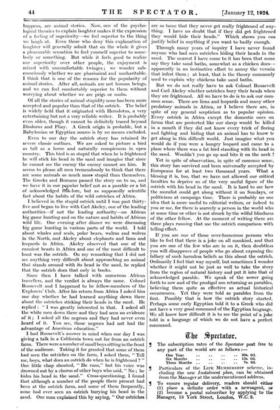POPULAR ERRORS.
By VILHJALMUR STEFANSSON.
IV.—THAT THE OSTRICH HIDES IIIS HEAD IN THE SAND.
ONCE upon a time there were two reglons of the earth where any fabulous story might be safely located, both because their character was well known, and because they were so remote and inaccessible that disproof was not easy. These were the tropics and the Arctic.
Knowledge has progressed since "once upon a time," and of the army of venerable myths localized by popular belief and scientific endorsement in the burning tropics and the frozen Arctic many have now had their day. For various reasons, only some of which are connected with physical difficulties, travel through the tropics has increased much faster than that in the remote North. For that reason the mortality among tropical myths has been extremely high. Still there are a few that survive to our day. Most of the surviving myths of the tropics, as it happens, are animal stories. Now, one of the psycho- logical theories to explain laughter makes it the expression of a feeling of superiority—we feel superior to the thing we laugh at. Even those who deny this explanation of laughter will generally admit that on the whole it gives a pleasurable sensation to feel yourself superior to some- body or something. But while it feels good to realize our superiority over other people, the enjoyment is mixed with uncomfortable twinges ; we wonder sub- consciously whether we are pharisaical and uncharitable.
I think that is one of the reasons for the popularity of animal stories. After all, animals are not human beings, and we can feel comfortably superior to them without worrying about whether we are prigs or snobs.
Of all the stories of animal stupidity none has been more accepted and popular than that of the ostrich. The belief is widely held that it originated with Herodotus, a very entertaining.but not a very reliable writer. It is probably even older, though it cannot be definitely traced beyond Diodorus and Pliny. A Greek origin is probable, but a Babylonian or Egyptian source is by no means excluded.
Even to our day the ostrich story has retained its severe classic outlines. We are asked to picture a bird as tall as a horse and naturally conspicuous in open 'country. This bird is so stupid that when he is frightened he will stick his head in the sand and imagine that since he cannot see the enemy the enemy cannot see him. It seems to please all men tremendously to think that there are some animals so much more stupid than themselves. The Greeks and Romans passed the story on to us, and we have it in our popular belief not as a parable or a bit of acknowledged f61k-lore, but as supposedly scientific fact about the habits of the wild ostriches of Africa.
I believed in the stupid ostrich until I was past thirty- five and began to live with Carl Akeley, one of the leading authorities—if not the leading authority—on African big game hunting and on the nature and habits of African wild life. One evening after dinner we were discussing big game hunting in various parts of the world. I told about whales and seals, polar bears, walrus and wolves in the North, and Akeley about elephants and lions and leopards in Africa. Akeley observed that one of the canniest beasts in Africa and one of the most difficult to hunt was the ostrich. On my remarking that I did not see anything very difficult about approaching an animal that stands around with its head in the sand, he replied that the ostrich does that only in books.
Since then I have talked with numerous African travellers, and the verdict is always the same. Colonel Roosevelt and I happened to be fellow-members of the Explorers' Club. After his return from Africa I asked him one day whether he had learned anything down there about the ostriches sticking their heads in the sand. He replied : "I was greatly interested in that. I asked all the white men down there and they had seen no evidence of it ; I asked all the negroes and they had never even heard of it. You see, those negrocs had not had the advantage of American education."
I had Roosevelt's answer in mind when one day I was giving a talk in a California town not far from an ostrich farm. There were a number of small boys sitting in the front of the audience. Taking it for granted that some of them had seen the ostriches on the farm, I asked them, "Tell me, boys, what does an ostrich do when he is frightened ? "
One little chap shouted, "He runs," but his voice was .drowned out by a chorus of other boys who said, " No ; he hides his head in the sand." Cross-questioning, I found that although a number of the people there present had been at the ostrich farm, and some of them. frequently, none had ever seen an ostrich burying his head in the• sand. One man explained this by saying, "Our ostriches are so tame that they never get really frightened of any- thing. I have no doubt that if they did get frightened they would hide their heads." Which shows you can justify belief in anything if you want to badly enough.
Through many years of inquiry I have never found anyone who had seen ostriches hiding their heads in the sand. The nearest I have come to it has been that some say they take sand baths, somewhat as a chicken does— apparently in an instinctive effort to annoy the vermin that infest them ; at least, that is the theory commonly used to explain why chickens take sand baths.
But we do not really have to ask Colonel Roosevelt and Carl Akeley whether ostriches bury their heads when they are frightened. All we have to do is to ask our com- mon sense. There are lions and leopards and many other predatory animals in Africa, or I believe there are, in spite of my general scepticism as to popular opinion. Every ostrich in Africa except the domestic ones on farms that are protected like our sheep would be killed in a month if they did not know every trick of fleeing and fighting and hiding that an animal has to know te get along in this difficult world. Just imagine what you would do if you were a hungry leopard and came to a place where there was a fat bird standing with its head in the sand. Wouldn't you go up and bite it on the neck ?
Yet in spite of observation, in spite of common sense, this story has survived and been universally accepted by Europeans for at least two thousand years. What a blessing it is, too, that we haye not allowed our critical faculties to deprive us of the very useful figure of the ostrich with his head in the sand. It is hard to see how the moralist could get along without it on Sundays; or politicians at campaign time. There is probably no one idea that is more useful to editorial writers, or indeed to you or me, for there is scarcely a person in the world who at some time or other is not struck by the wilful blindness of the other fellow. At the moment of writing there are three plays running that use the ostrich comparison with telling effect.
If you are one of those over-humorous persons who like to feel that there is a joke on all mankind, and that you are one of the few who are in on it, then doubtless you will disapprove of people who go about exposing the fallacy, of such harmless beliefs as this about the ostrich. Ordinarily I feel that way myself, but sometimes I wonder whether it might not be just as well to take the story from the region of natural history and put it into that of acknowledged parable. We speak of the sower going forth to sow and of the prodigal son returning as parables, believing them quite as effective as actual historical occurrences. Yet they were told as parables from the first. Possibly that is how the ostrich story started. Perhaps some early Egyptian told it to a Greek who did not have a very good command of the Egyptian language. We all know how difficult it is to see the point of a joke told. in a language of which we do not have a perfect command.







































 Previous page
Previous page